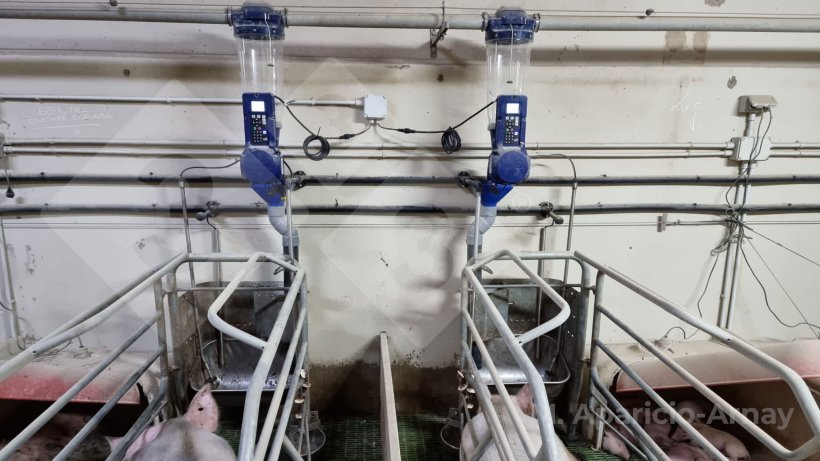In recent years, technology has revolutionized the way farm animals are fed, especially lactating and gestating sows. In this regard, one of the most promising advances in swine production is precision feeding, especially during a sow's lactation, due to the use of hyperprolific lines that are more prone to metabolic and nutritional disorders, thus compromising the growth of their piglets during lactation and their subsequent performance.
According to some authors, such as Dr. Cándido Pomar and his colleagues (Pomar et al., 2019), precision feeding consists of providing individuals or small groups of animals with the amount of nutrients that maximizes their metabolic utilization in real time without compromising performance. According to these authors, precision feeding requires automatic and frequent data collection, data processing, and actions related to controlling the feeding system. This is achieved through the use of electronic sow feeders (ESF) as described by other authors.

Recently, three studies conducted by Aparicio-Arnay and colleagues (Aparicio et al., 2024; Aparicio-Arnay et al., 2025a, 2025b) at the Granja San Pedro owned by Cuarte, S.L., located in Plasencia de Jalón in the Spanish province of Zaragoza, have shown that implementing precision feeding through the use of electronic feeders not only improves the performance of sows and their piglets, but also provides economic, environmental, and animal welfare benefits compared to traditional feeders. The main findings of these three studies are summarized below.

Photo 1. Precision feeding during sow lactation.
More kilograms of higher quality pork with less feed
One of the most consistent and demonstrated findings in these three studies is that sows fed with electronic feeders wean heavier piglets using a smaller amount of feed. This is mainly due to the reduction in feed wastage. One of the studies reported an up to 32 kg reduction in feed per sow per lactation compared to traditional feeders while the other two studies reported a 23 kg reduction. This represents a significant economic savings for the farms. For example, on a farm with 1,000 sows, like the one in the studies, this could represent a savings of around 50,000 euros per year, and that's being conservative.
Furthermore, coinciding with previous studies (Moest et al., 2023), a third of these trials (Aparicio-Arnay et al., 2025b) conclude that piglets fed with electronic systems had heavier weaning weights, according to the results obtained, and had higher average daily gain (ADG) both in the nursery and in finishing and a better feed conversion ratio compared to their peers- offspring of dams fed with traditional feeders during lactation.
Thus, piglets whose dams were fed with electronic feeders weighed 1.24 kg more at the end of the nursery phase (68 days) and 7.15 kg more at the end of the finishing phase (192 days). The benefits derived from this higher slaughter weight are calculated directly by selling more kilograms of pigs and also indirectly by decreasing the number of days the pigs spend in the barn.
Table 1. Mean (± SD) weight (kg) and mean daily gain (ADG; kg/day) at the end of the nursery phase (day 68) and at the end of the finishing phase (192 days) of pigs whose dams were fed with electronic feeders or with the traditional system during lactation.
| Group | |||
|---|---|---|---|
| Electronic feeder | Traditional feeder | P value | |
| Weight on day 68 | 20.59 ± 4.21 | 19.35 ± 4.06 | <0.001 |
| ADG 24-68 | 0.332 ± 0.92 | 0.312 ± 0.80 | 0.006 |
| Weight on day 192 | 128.54 ± 14.56 | 121.12 ± 12.53 | <0.001 |
| ADG 68-192 | 0.921 ± 0.11 | 0.871 ± 0.09 | <0.001 |
The analysis of post-slaughter weights showed heavier carcass weights (Table 2) and heavier bone-in and deboned primal cuts, accompanied by a higher quality of these cuts in terms of fat/lean ratio (Table 3).
Table 2. Mean (± SD) carcass weight, carcass yield, carcass lean content, backfat thickness, and loin diameter of pigs whose dams were fed with electronic feeders or with the traditional system during lactation.
| Group | |||
|---|---|---|---|
| Electronic feeder | Traditional feeder | P value | |
| Carcass wieght (kg) | 105.17 ± 15.92 | 97.98 ±20.25 | <0.001 |
| Carcass yield (%) | 80.63 ± 5.89 | 80.36 ± 3.01 | 0.684 |
| Lean carcass (%) | 62.31 ± 4.92 | 61.39 ± 10.95 | 0.325 |
| Back fat (mm) | 16.2 ± 3.10 | 15.03 ± 3.57 | 0.003 |
| Loin diameter (mm) | 73.08 ± 8.13 | 69.78 ± 13.69 | 0.010 |
Table 3. Mean (± SD) weight (kg) of bone-in and boneless primal cuts and total lean weight (leg, shoulder, loin, and belly) of pigs whose dams were fed with electronic feeders or with the traditional system during lactation.
| Group | |||
|---|---|---|---|
| Electronic feeder | Traditional feeder | P value | |
| Bone-in loin | 9.08 ± 1.35 | 8.35 ± 1.81 | <0.001 |
| Boneless loin | 8.13 ± 1.24 | 7.45 ± 1.63 | <0.001 |
| Lean loin | 5.93 ± 0.71 | 5.55 ± 1.12 | <0.001 |
| Bone-in leg | 13.56 ± 1.74 | 12.67 ± 2.59 | <0.001 |
| Boneless leg | 12.77 ± 1.62 | 11.85 ± 2.41 | <0.001 |
| Lean leg | 10.51 ± 1.27 | 9.84 ± 1.98 | <0.001 |
| Bone-in shoulder | 7.88 ± 1.06 | 7.24 ± 1.52 | <0.001 |
| Boneless shoulder | 7.15 ± 0.98 | 6.65 ± 1.40 | <0.001 |
| Lean shoulder | 5.57 ± 0.70 | 5.20 ± 1.07 | <0.001 |
| Bone-in belly | 4.84 ± 0.69 | 4.44 ± 0.94 | <0.001 |
| Boneless belly | 4.50 ± 0.66 | 4.12 ± 0.89 | <0.001 |
| Lean belly | 2.99 ± 0.36 | 3.00 ± 0.57 | <0.001 |
Improved sow health and welfare without compromising fertility
Despite consuming less feed, sows fed with electronic feeders lose less weight during lactation and maintain good body condition (measured as change in backfat thickness). This is key for their health and to ensure rapid reproductive recovery after weaning. In addition, the studies found no negative effects on fertility or on the number of piglets born in the next parity. In terms of welfare, lower levels of stress (measured by salivary biomarkers such as alpha-amylase) were observed in sows fed with electronic feeders in one of the farrowing rooms, where the sows were positioned face-to-face (59.17 ± 61.67 U/L for electronically fed sows vs. 410.47 ± 61.67U/L for traditionally fed sows).

Photo 2. Precision feeding during sow lactation.
A step towards sustainability
Beyond the production benefits, precision feeding contributes to more sustainable pig production. By reducing feed waste, the environmental impact associated with pork production and waste management is reduced. It also optimizes the use of nutrients such as nitrogen and phosphorus, reducing their excretion into the environment. Precision feeding using electronic feeders represents a very powerful tool for improving efficiency, animal welfare, and sustainability in pig production. These studies demonstrate that, by incorporating technology such as electronic feeders, it is possible to produce more and produce better while taking care of both the animals and the planet.



